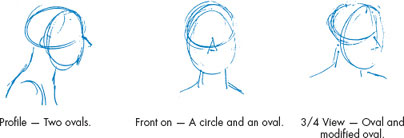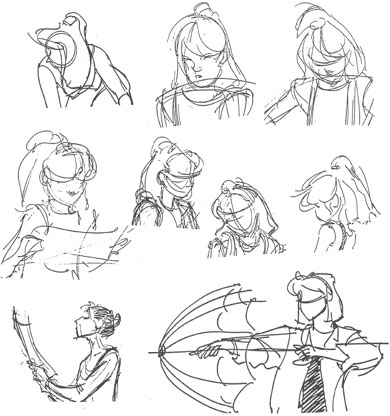We have spent some months now sketching the figure with special emphasis on gesture. In my estimation it has been a rewarding experience. I have stressed its inclusion at all parts of the body including the hands and feet because they are such an important part of any pose or gesture. No parts of the body have been isolated as more important than any other simply because body language entails all of the parts. An exception to that rule occurs in animation where close-ups or waist shots are featured. Because of this, it behooves us to spend some time in a study of heads and the upper torso. The emphasis should still be on gesture, and as we did with the rail figure, ignore the details as much as possible. A very simple symbol for the head shape, eyes, nose, and mouth will suffice to “nail down” the gesture or expression. We are all at different stages of drawing ability, so some may feel it unnecessary to start with such simple shapes. If so, try to treat it like a refresher course and spend a little time at it.
Basically, the head from a front view is an egg shape, and from the side it is two egg shapes (see the following illustrations). This is an oversimplification, but is useful in laying out the first stages of a drawing. Head shapes vary in many ways and once an individual’s variances are discovered, they can be exploited to acquire a likeness or if desired, carry them farther into caricature. A person’s real head and feature shapes cannot really be known until we have seen that person from different angles and in different moods and circumstances such as laughter, anger, fear, clowning, seriousness, strain, etc.
In animation most needs have been built on the circle. Cheeks have been added or mouse ears or duckbills have been added and suddenly there is a universally appealing character. I said suddenly, but the truth of the matter is, many months of intensive search and experimentation have preceded the final acceptance of most character models. Some, such as Mickey Mouse and Donald Duck, have continually evolved their entire lifetime. Because many characters are built somewhat on the same basic formula, great care must be taken to retain the subtleties that distinguish one from another. Animation allows the characters to be freely caricatured in action but though the shapes are stretched and squashed to unbelievable limits, they must be recognizable as that character at all times. A good model is one that has shapes that can be animated into various poses and expressions without losing its character. The general shape of the head and its individual features must be established in its normal state first so that squashes and stretches will be recognized as such. In other words, a thoroughly recognizable norm will serve to emphasize any deviation; giving added punch and authority to special expressions. On the other hand, since we have already enjoined the audience to suspend their disbelief in such beings as talking mice and temperamental ducks, it is important to sustain this newly created plausibility by keeping the characters consistent. Studying the model and people in general with this in mind gives us purpose and hopefully the added incentive to do so.

Approximate limitations of looking up and down and sideways using neck.

Looking up and down not using neck.
Some of your drawings from the class are suggestive of the way I think the head studies might go. They are simple enough to allow the express to beam through, not weighted down with tons of ostentatious falderal.



